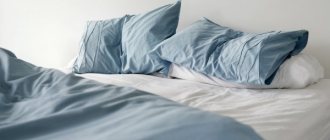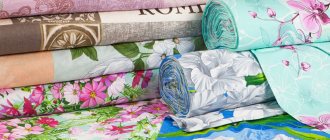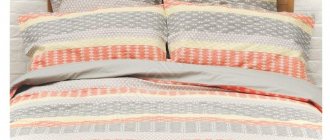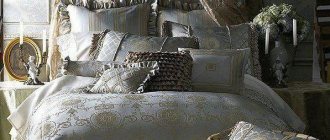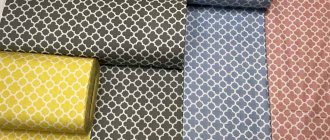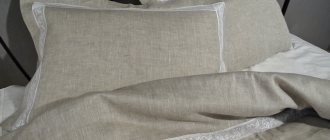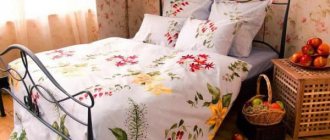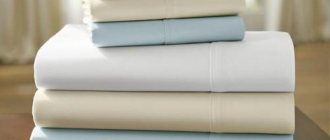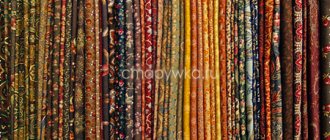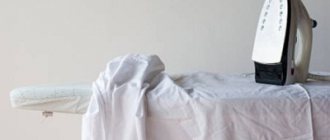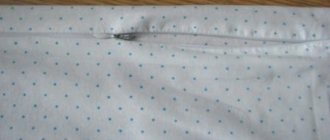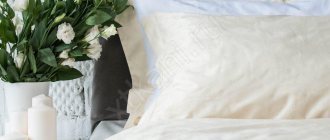Despite the fact that the bed linen market is growing every year, it is not always possible to find a bed that is suitable in size, fabric, color and other parameters. That is why handmade tailoring does not lose its relevance. Previously, all housewives could sew even a duvet cover, even a dress, as this was one of the housekeeping skills. Today only a few people know how to sew. Today we will talk about how to sew bed linen yourself, what you will need for this, and also teach you how to calculate the required amount of materials.
What you need
Particular attention is paid to the choice of fabric. It provides a comfortable sleep. Material required
must be hypoallergenic and natural. It is important that the fabric breathes and absorbs moisture well. It is equally important that the bed does not become electrified and does not slip too much. It is not recommended to sew a bed from synthetic materials or a mixture of natural and synthetic ones. They do not allow air to pass through, so they cause discomfort during sleep.
The price range for bedding materials varies from affordable for every wallet to quite high. Many housewives choose cotton. This is the best option in terms of price and performance properties. Cotton is easy to wash, absorbs moisture during sleep, and does not deform. The disadvantage of cotton fabrics is shrinkage at the beginning of use. It accounts for up to 7% of the size. When choosing such a material for sewing, it is necessary to take this fact into account and make a reserve when measuring.
Making a bed is possible not only from cotton. The following fabrics are also suitable:
- Calico is an inexpensive material that has the properties necessary for bedding. It tolerates washing well, is wear-resistant, does not lose color for a long time, and does not fade.
- Chintz is considered the most inexpensive natural fabric. It is inferior in wear resistance to other materials, and quickly loses its appearance. Chintz is breathable and does not cause allergic reactions.
- Satin is a strong and durable material. It is more expensive than cotton, but the price is justified by its service life.
- Flannel has characteristics similar to calico. It provides a comfortable sleep and lasts a long time. Over time, the fabric becomes softer and more pleasant to the body.
- Silk is an expensive and high-quality material. Beginning seamstresses should not use it for sewing bedding, as it is difficult to work with without experience.
- Linen is a high-quality, natural and environmentally friendly product. Its use for sewing linen yourself is not recommended due to its rigidity. The cost of the fabric is above average.
Before sewing bed linen, you should also stock up on the following materials and tools:
- threads;
- sewing machine;
- pins;
- scissors;
- needles.
To sew a high-quality bed, you need to pay attention to the threads. It is recommended to choose synthetic threads. They do not fray and retain their shape longer. The label says 100% polyester. It is better to give preference to threads made from Polstrong, Durafix or Capitonne threads.
Sizing and calculating the amount of fabric
To calculate the correct amount of fabric, you need to determine which set you want to receive. Consider how many pillowcases, sheets and duvet covers you will need. To calculate the fabric, use the bed linen size table below. The sizes presented in the table are standard. If your pillow, blanket or mattress differs from the usual dimensions, you should not rely on these parameters.
Table - Sizes and accessories of bed linen
| Name | Complete set (sheet – R, duvet cover – R, pillowcase – N) | Sheet, cm | Pillowcase, cm | Duvet cover, cm |
| Single | 1 R, 1 R, 1 N | - 110x200; - 110x210; — 110x220 | - 50x70; — 60x60 | — 135x200 |
| 1.5 bedroom | 1 R, 1 R, 1 N | - 150x215; - 160x210; - 160x220; — 180x260 | - 50x70; - 60x60; — 70x70 | - 150x210; — 150x220; — 160x200 |
| Double | 1 R, 1 R, 2 N | - 175x210; - 175x215; - 210x230; - 220x220; — 220x240 | - 50x70; - 60x60; — 70x70 | - 175x210; - 180x210; - 180x215; — 200x220 |
| Euro kit | 1 R, 1 R, 2 N | - 215x240; — 220x250; — 240x260; — 220x270 | - 50x70; — 70x70 | - 200x220; - 205x225; — 220x240; — 225x245 |
| Family | 1 R, 2 R, 2 N | — 240x260; — 240x280 | - 50x70; — 70x70 | - 150x210; — 160x220 |
| Children's | 1 R, 1 R, 1 N | - 145x220; — 150x210 | - 50x50; — 50x70 | - 150x210; — 153x215 |
If you decide to sew bedding for your child, be sure to measure the dimensions of the crib before creating a pattern.
Drawing up a diagram
It is very important to correctly calculate how much fabric is needed to sew bed linen, so as not to make a mistake with the sizes. If you buy less material, you may end up without a pillowcase or have to discard the sheet. To prevent this from happening, take paper and sketch out an approximate diagram, carefully recording all the dimensions. Typically the width of the fabric is 220 cm. For example, if you want to sew a 1.5-bed set, the calculation will look something like this.
- Bed sheet. The standard width of a mattress is 120x190 cm. Therefore, the width of the sheet should be 120 cm + 30 cm (free sagging on one side) + 30 cm (sagging on the other side), a total of 180 cm. The length of the product will correspond to the width of the sheet - 220 cm. In the diagram step back 180 cm from the edge.
- Duvet cover. The standard dimensions of the blanket are 140x200 cm. To determine the width of the required material, make the following calculation: 140 cm (one surface of the duvet cover) + 140 cm (second surface) + 10 cm (for loose fit) + 10 cm (for shrinkage) + 10 cm (allowance for seams). Total 310 cm. The length will also be 220 cm. Mark another rectangle on your diagram with dimensions 220x310 cm.
- Pillowcase. If the pillow is 70x70 cm, then the calculation is carried out as follows: 70 cm + 10 cm (for loose fit and seam allowance) + 10 cm (for shrinkage), total 90 cm. Mark the pattern of the pillowcase on the diagram, retreating 90 cm along the edge. Set it down. 70 cm (one surface of the pillow) + 70 cm (second side) + 20 cm (for valve) + 10 cm (for allowance) + 10 cm (for shrinkage). Total 180 cm.
Now all that remains is to add up all the resulting dimensions: 180 cm (sheet) + 310 cm (duvet cover) + 90 cm (pillowcase) = 580 cm. This means that for a 1.5-bedroom set you will need a piece of fabric 6 m long, with a width of 2 ,20 m.
Shape selection
Previously, all mattresses and pillows had standard sizes, so the choice of shape was not so important.
There are different shapes of mattresses and pillows available on the market today. If you need a sheet for a sofa bed, a regular sheet without elastic will do. For a traditional bed, many people choose a bed with elastic bands, which provide a tighter fit and better grip. Pillows also come in different sizes and thicknesses. Many people are faced with the fact that when buying a pillowcase that seems to be the right size, they cannot put it on the pillow, since it is very “high” and does not fit into the pillowcase. When sewing, it is recommended to add a few centimeters to the thickness.
How to sew a sheet yourself
Rice.
1. Correctly fold the fabric for the sheet The image shows what needs to be done so that the material for the sheet does not have a crooked side after purchasing it at a textile store / cutting it from your stocks.
Instead of blindly cutting one side, which most often turns out crooked, no matter how hard you try and do not use a ruler (the point is the perspective effect of the human eye) - fold the base in half, align the edges and cut, focusing on the fold.
The standard width of a sheet for one person is one and a half meters.
To choose the right sheet size for your bed or sofa, you need:
- Add fifteen centimeters to the length of the bed (five centimeters for seams, allowance and the possibility of reducing the size of the fabric after a hot wash);
- Follow the instructions for correctly separating the amount of material we need:
Rice.
2 - make the blank yourself By the way, making a sheet is the easiest stage of our work.
Now let's start hemming the fabric. This is done both from the front side and from the back.
Let's start with ironing - bend about a centimeter in each direction and iron the resulting bend:
Rice. 3 - ironing the front side
Repeat this on the other side:
Rice. 4 - ironing the wrong side
Then, in order to avoid routine and not particularly beautiful manual work, we will sew the resulting folds with a machine (the fold is done on the wrong side, of course):
Rice. 5 - sew the fabric using a sewing machine
I recommend stitching the fabric several times in a parallel course - you understand that one thread is not enough during active use and washing. Either by moving the machine in reverse, or, if there is none, turning the fabric one hundred and eighty degrees so that the stroke of the thread forms a twisting spiral:
Rice. 6 - stitch the fabric several times
Let's take pictures and admire:
Rice. 7 - the sheet is ready
Pattern
An experienced seamstress carries out sewing without using a pattern for a duvet cover, pillowcase and sheet, but a novice master needs it. On the Internet you can find diagrams for any size bed. You can also use our examples of cutting bed linen.
Option 1
Option 2
What fabric to choose for a set of linen?
Traditionally, bed linen is made from cotton fabric, which has no analogues in lightness and hygiene. The most reliable material options are calico, satin and percale. These fabrics can withstand many washes without changing color or quality, do not wear out for a long time and have an attractive appearance.
Chintz is inferior to the named fabrics in all respects, but due to its soft and delicate structure, many mothers use chintz to sew children's bedding.
For the cold season, home kits can be made from flannel or terry jersey. Many people like silk bedding. This expensive fabric has a dense structure and a smooth satin surface.
Step-by-step description of production
So, we sew bed linen with our own hands. Before you start sewing, you need to cut the bed linen correctly. To do this, use a pattern. Before cutting the fabric, you can make your work easier by drawing the future product on the material with crayons or a bar of soap.
Sewing sheets
If the size of the sheet covers the entire width of the fabric, then there is an edge on both sides. In this place, processing of the material is not necessary, since the edge does not unravel when washed. In untreated areas, the bed needs to be treated. To do this, make a hem around the perimeter of 1 cm and the same amount again, then stitch.
Sewing a duvet cover
Sewing steps:
- Fold the cut fabric in half with the wrong side out.
- Sew the fabric along the edge if the material is cut across the entire width.
- If not, make a line at a distance of 1.5-2 cm around the perimeter, then process it with an overlocker. Don't forget to leave a hole for the blanket measuring 50-70 cm.
- Press the seams.
- Turn the duvet cover right side out.
- In the raw area (where the blanket goes), fold the fabric 1 cm into the inside of the duvet cover and stitch.
- If the hole is large, you can sew in a lock or sew on buttons.
- Press the seams.
Detailed step-by-step instructions for beginners. Part 1 (choosing a design, taking measurements, creating a pattern, calculating fabric consumption, preparing fabric for cutting and cutting)
The importance of healthy sleep cannot be overstated. We sleep for almost a third of our lives. During sleep, our body rests and recovers. Good sleep improves your mood, gives vital strength and vigor for the whole day. With regular lack of sleep, a person’s immune system weakens, frequent headaches appear, feelings of irritation and sudden mood swings arise, the risk of heart disease increases, apathy and depression sets in, performance decreases, the aging process accelerates, memory, attention and vision deteriorate.
One of the factors influencing the quality of sleep is good bedding made from natural fabrics. Today, manufacturers offer a wide range of bedding sets, differing in design, size, colors, materials, quality of tailoring and price. However, a standard factory product does not always meet our requirements. In this case, the ideal option would be to sew your own bed linen. A set of bed linen sewn by the golden hands of a caring housewife will be valued much higher than those bought in a store, and sleeping on it will be much more pleasant.
The benefits of making your own bed linen
1. Color
With all the variety of ready-made bed linen, there are much more colors of fabrics from which you can sew it yourself. Plain, in various colors and shades, matched exactly to the color scheme of the bedroom, with various designs, prints and patterns, with images on a variety of topics, two-color, with appliqués and other decorative elements - this is not a complete list of options possible when sewing yourself.
2. Size and completeness (number of items)
The size of bed linen directly depends on the size of the bed, pillow and blanket. In the industrial production of bed linen, standard sizes are used. Below is a table of standard finished bed linen sizes (excluding seam allowances).
Table of standard sizes of finished bed linen
If the bed and bedding have non-standard sizes, then custom tailoring easily solves the problem. In addition, sheets and pillowcases wear out faster than duvet covers, so when sewing a set yourself, you can adjust the number of necessary items yourself, whereas in ready-made sets the quantity is standard.
3. Fabric composition, quality of tailoring, consumables and accessories
It is no secret that some unscrupulous manufacturers sacrifice quality in pursuit of profit. When sewing bed linen, low-quality, sometimes synthetic, fabrics are used; to save time and consumables, the technology of sewing and processing seams is violated, low-quality products are not rejected. This leads to rapid wear and tear of the bed linen and, as a result, after a short time you have to incur additional costs for purchasing a new set.
When you sew your own bed linen, you are the one who chooses the fabric and threads, knowing exactly their composition, strength and density. Only you, and no one else, independently control the quality of tailoring and, if you make a mistake, you can easily correct it.
Today the market offers a huge selection of fabrics for sewing bed linen. Natural cotton and silk fabrics are considered classics for comfortable sleep: - chintz - soft, thin fabric, not particularly strong and durable, but well suited for sewing children's bedding or a set for a newborn; — calico is a dense, slightly rough material that, as a rule, does not lose color over time, but becomes softer during use, without losing its strength and wear resistance; - satin - soft and pleasant to the touch fabric with a slight sheen and good hygroscopic properties; - cambric - wears out quickly, but is light, soft, thin and flowing fabric; - flannel - soft and pleasant to the touch fabric is ideal for sewing children's bedding or a set for a newborn; — linen is a durable and safe fabric that does not cause allergic reactions in the body; - poplin - smooth, practically wrinkle-free, thin fabric of increased strength; - bamboo fabric - soft and smooth, absorbs and quickly evaporates moisture, has antibacterial properties; — silk is a beautiful-looking, smooth, hypoallergenic, highly breathable fabric.
4. Design
There are several options for sewing the components of a bedding set.
a) Bed sheet: - the classic model of the sheet is a straight sheet, processed along the edges. This model is well suited for all types of beds due to its versatility, since the margin at the edges makes it easy to tuck in the sheet. However, this option wrinkles and slides off during sleep; — a sheet with an elastic band or a fitted sheet is suitable for those who like to actively toss and turn in their sleep. Thanks to the elastic band, which can be sewn either around the entire perimeter of the sheet or only at its corners, the sheet is securely fixed to the mattress. However, this model is not suitable for sofas, and its size must exactly match the size of the mattress.
b) Pillowcase: - a classic version of the “envelope” pillowcase, with a flap or a wrap on the side or bottom, external or internal, without additional fasteners, easy to use and sew; — an Oxford pillowcase or one with “ears” has margins along the edges, which makes it look interesting, elegant and original; - a pillowcase with ties on one side is mainly used for decorative pillows, but can also be used for bedding; - a pillowcase with buttons on the side along the length or width, as well as in the middle, secures the pillow well and can become an original decorative element; - a pillowcase with a zipper on the edge (along the length or width) or in the middle, with or without a valve, is considered the most convenient way to secure a pillow in a pillowcase.
c) Duvet cover: - a duvet cover with a square, diamond-shaped or rectangular cutout in the center of the outer side that does not completely protect the blanket from contamination; - a duvet cover with a side cutout along the length or the short side, with or without a flap, without a fastener, fastened with buttons or a zipper is more practical to use.
5. Beginner to sewing
If you are just learning to sew, then sewing a bedding set is a great way to acquire initial cutting and sewing skills. The sewing process is quite exciting and not at all difficult.
6. Benefit in price
It is difficult to say how much more profitable sewing is compared to buying, since pricing is influenced by many factors, for example: - a clothing factory buys materials, tools and equipment in bulk, which undoubtedly costs it less than retail purchasing everything necessary for home sewing; — at the factory, a whole staff of employees works on one set of bed linen and they need to pay wages, while we spend only our free time on sewing; — not all garment factories work directly with the end consumer; accordingly, the initial cost of a factory set increases by the size of the intermediary’s markup.
Step-by-step instructions for sewing bed linen with your own hands
I. Choose (come up with) a design
After studying all the possible options, it’s time to turn on your imagination and come up with your ideal and unique bedding design for tailoring.
I will sew a two-color custom-sized set for a single (teenage) bed, consisting of: two fitted sheets with corner elastic bands, four pillowcases with a side hidden zipper with a flap for two pillows, and one duvet cover also with a side secret zipper with a flap.
II. Taking measurements
The process of sewing any product begins with taking measurements, the main purpose of which is to determine the dimensions of the finished product for further calculation of fabric consumption and construction of a pattern. The quality, appearance and correct fit of the finished product depend on the accuracy with which the measurements are taken. Measurements are taken and recorded in centimeters with rounding accuracy, in the case of bed linen, up to 1 centimeter upward. For example, if when taking a measurement the value is 17.52 cm, its value is rounded to 18 cm, and 17.22 cm is rounded to 18 cm.
To take measurements we will need: - a sheet of paper, a notebook or notepad for notes; - a pen or (better) a simple pencil with an eraser; - measuring tape (sewing (tailor's) centimeter); - bedding items that we will measure (mattress, pillow, blanket).
Prepare a table for taking measurements in advance, as shown below, and fill in the empty cells during the measurement process. A ready-made table for taking measurements can be downloaded under the article in the “Download additional material” section (the download link is available only to registered users).
* Increase for loose fit
necessary to give the product volume, ease of making the bed, and also to ensure that the fabric and seams during the operation of the product do not receive additional load, stretch or tear. Its size depends on additional elements on the mattress (bulges, piping along the edge, the presence of a mattress cover, zippers, etc.), the thickness of the pillow and blanket.
If you plan to sew standard size bed linen according to the measurements indicated on the tags, you should not trust the manufacturers and skip the process of taking measurements, since the actual size differs from the declared one, at least by the amount of increase for a loose fit.
a) Taking measurements of the mattress
We measure the length, width and height of the mattress, and record the results in a table. When taking measurements, make sure that the measuring tape runs exactly in a straight line, perpendicular to the edges of the mattress from which the measurement begins. In my case, the size of the mattress is 200x90x20 cm. I use a mattress cover with a convex pattern, which has a small thickness and a decorative edging along the edges 1 cm wide, so I add 3 cm for a loose fit. on each side in length and width.
b) Taking pillow measurements
The pillow, in addition to its length and width, has a thickness, which is quite problematic to measure separately, so it is better to take measurements along the circumference, straightening the pillow well, without pressing the measuring tape too hard.
We divide the results obtained in half, rounding up. I got 2 circles with a length of 96 and 136 cm. Accordingly, the size of the pillow is 48x68 cm. Taking into account the fact that when taking measurements we did not allow the pillow to be “tightened”, we add 1 cm for a loose fit on each side in length and width . We record the results obtained in a table.
c) Taking measurements of the blanket
Let's start measuring the blanket, taking measurements of length and width. Try to spread the blanket evenly on the bed.
In my case, the actual size of the blanket is 150x205 cm, although the manufacturer's tag indicates 155x215 cm.
It is worth noting that the blanket can be summer, demi-season or winter, and have different fillings, which affects its thickness. We adjust the thickness by using allowances for a loose fit. I have a winter blanket made of bamboo fiber, which is quite thick, so I add 3 cm to the loose fit on each side in length and width. We record the results obtained in a table.
III. Construction of a pattern (drawing)
After taking measurements, a pattern for the future product is created. Since bed linen does not have complex structural elements, the pattern will be drawn directly on the fabric before cutting, and to calculate the fabric consumption I will draw a drawing, that is, a pattern in reduced dimensions of 1:10 cm.
To construct a drawing we will need: - a table with measurements taken; — A4 paper; - a simple pencil with an eraser; - ruler and square; - calculator; - stationery scissors.
a) Drawing of the sheet
— build a rectangle with a width and length equal to the width and length of the mattress, in mm; — on each side we make an increase for a loose fit, in mm;
- on each side add a measurement equal to the height of the mattress, in mm. If you are sewing a classic sheet, then you should increase the height of the mattress only in width + add 5-10 cm to the fold of the sheet.
— in the “addition for decorative elements” column of the table with measurements, write down the added height of the mattress
b) Pillowcase drawing
The classic version of the “envelope” pillowcase without a fastener is sewn from one rectangular piece with 2 folds. In this case, the length of the rectangle = the length of the pillow x 2 + the size of the valve (equal to 1/2 the length of the pillow), and the width of the rectangle = the width of the pillow. To the resulting rectangle you need to add an increase on each side for a loose fit.
My pillowcases will be made from 2 fabrics of different colors with a small decorative flap of 2.5 cm, under which a zipper will be hidden. To construct a drawing of a pillowcase with a zipper: - draw a rectangle with a width and length equal to the width and length of the pillow, in mm; — on each side we make an increase for a loose fit, in mm;
- draw the bottom part of the pillowcase - a rectangle with a width and length equal to the width and length of the pillow + allowance for a loose fit + valve width x 2
— in the “addition for decorative elements” column of the table with measurements, write down the added valve size
c) Duvet cover drawing
A classic duvet cover without a fastener is sewn from one rectangular piece with a fold. In this case, the length of the rectangle is equal to the length of the blanket, and the width = the width of the blanket x 2. To the resulting rectangle, you need to add an increase on each side for a loose fit. For ease of tucking the blanket, a side hole is made along the length or width, equal to approximately 1/2-1/3 of the width of the blanket.
My duvet cover will be sewn from 2 rectangular pieces of fabric of different colors with a small decorative flap of 2.5 cm, under which a zipper will be hidden. To construct a drawing of a duvet cover with a zipper: - draw a rectangle with a length and width equal to the length and width of the blanket, in mm; — on each side we make an increase for a loose fit, in mm;
- draw the bottom part of the duvet cover - a rectangle with a length and width equal to the length and width of the blanket + allowance for a loose fit + flap width x 2
— in the “addition for decorative elements” column of the table with measurements, write down the added valve size
Next, you need to decide on the seams that will be used when sewing bed linen in order to calculate seam allowances. Now many sewing factories use an overlocker to process seams, while the seam allowance is 0.5-1 cm. This saves the consumption of fabric and time for sewing, but has a negative impact on the quality of the products. After several washes in the washing machine at high temperatures and spinning, the seams may begin to unravel and the threads at the edges may begin to fray. Even more unsuitable for sewing zigzag seams on a household sewing machine.
For processing free edges, a hem seam with an allowance of 2 cm is best suited, and for sewing two parts together, a hemming seam with an allowance of 1 cm on one part and 2 cm on the second. When sewing a classic duvet cover, you can use a double seam with an allowance of 1.5 cm.
Hem
used when hemming the free edge of products. The trimmed edge is folded to the wrong side by 1 cm, then folded again by 1 cm and stitched at a distance of 0.2 cm from the folded edge. As a result, the hem seam is 3 layers thick.
Covering (linen) seam
used when sewing two parts together. First, the parts are laid out so that the edge of the lower part protrudes by 1 cm and the first line is laid at a distance of 1 cm from the edge of the upper part. Then the edge of the lower part is bent by 1 cm, bent a second time by 1 cm, the seam is opened and the second line is laid at a distance of 0.2 cm from the fold. As a result, the sewing seam turns out to be 4 layers of fabric thick.
Double seam
used when sewing two parts together. The parts are folded with the wrong side inward. The first line is laid at a distance of 0.7 cm from the edge. The parts are turned inside out and at a distance of 0.8 cm from the edge (fold points) a second line is laid so that the raw edges of the product remain inside the seam. The finished seam is pressed onto one side, forming a thickness of 5 layers of fabric. (double stitching will not be used for the bedding I have in mind).
Having decided on the types of seams and allowances for them, we fill out the last column of the table with measurements and record the amount of seam allowance in the drawings.
Thus, we received the dimensions of bed linen with allowances for loose fit and decorative elements, as well as seam allowances: - fitted sheet - 250x140 cm; - lower part of the pillowcase - 54x78 cm; - upper part of the pillowcase - 52x74 cm; - lower part of the duvet cover - 160x219 cm; — the top part of the duvet cover is 158x215 cm.
A drawing of a classic bedding set with seam allowances will look like this:
From the finished drawings we cut out a number of parts equal to the number of items in the bedding set. In my version: - for 2 sheets - 2 parts; - for 4 pillowcases - 4 pieces each of the upper and lower parts; - for 1 duvet cover - 1 piece each for the top and bottom.
Now you need to shape the corners of the sheet. To do this, in the drawing, from the edges in the corners horizontally, we put aside a value equal to the height of the mattress, and vertically - the value of the height of the mattress + 1 cm. Thus, at the corners of the sheet we got 4 rectangles measuring 20x21 cm with ready-made seam allowances of 1 and 2 cm Cut out the resulting rectangles.
IV. Fabric consumption calculation
Linen fabric differs not only in composition, but also in the width of the rolls. Typically, store shelves offer fabrics with a width of 150 to 220 cm; wider ones are less common - up to 300 cm. Moreover, the price of wider fabric does not always increase in proportion to the increase in footage. Therefore, proper layout of the pattern on the fabric and accurate calculation of fabric consumption can significantly save money on sewing bed linen.
When laying out a pattern on fabric, it is necessary to take into account some features of the structure and color of the fabrics: - the length of the fabric consists of longitudinal threads (warp threads), and the width - of transverse threads (weft threads). For bed linen, the coincidence of the longitudinal and transverse threads of the fabric with the length and width of the product does not matter. When laying out a pattern on fabric, you only need to ensure that the parts of one product, for example, the upper and lower parts of the pillowcase, have the same direction of the threads;
- if the fabric has a characteristically pronounced pattern, the pattern should be positioned in such a way that the pattern does not move when sewing the seams;
There is another important point when calculating fabric consumption. All fabrics tend to shrink (reduce in size) when soaked, washed or steamed. Based on the amount of shrinkage, fabrics are divided into three groups: 1) non-shrinkable - shrinkage along the warp and weft up to 1.5%; 2) low-shrinkage - warp shrinkage up to 3.5%, weft shrinkage up to 2%; 3) shrinkage - shrinkage on the warp up to 5%, on the weft up to 2%. Depending on the composition, the presence of natural and synthetic fibers, the fabric can shrink significantly more. For example, cotton fabrics can shrink 5-10%. It is better to check the shrinkage percentage not on the Internet, but with the seller, immediately before purchasing the fabric. It is necessary to increase the estimated cut length by the amount of shrinkage!
According to my standards, in order not to make additional seams in the middle of the products, fabric with a width of 160 or 220 cm is suitable. I take colored paper of the same width on a scale of 1:10 and begin to lay out patterns on it to determine the required length of the fabric cut.
The process of laying out a pattern on fabric is a bit like putting together a puzzle. The patterns are laid out, rearranged, and swapped until their optimal placement is found.
For a two-color bedding set, with a fabric width of 160 cm, I need 2 pieces of different colors, 569 and 577 cm long. +% for fabric shrinkage. Taking into account possible weft shrinkage, a width of 160 cm is not enough, and you may have to buy fabric 180 cm wide!
For a two-color bedding set, with a fabric width of 220 cm, I need 2 pieces of different colors, 408 and 410 cm long. +% for fabric shrinkage. There is also a small amount of fabric left for shrinkage along the width of the upper parts. The valves of the lower parts of the pillowcases and duvet cover, if the fabric shrinks in width, may have to be moved to the other side; accordingly, the width of the valve (5 cm) will need to be added to the length of the cut (410 + 5 = 415 cm).
V. Selecting fabric and consumables, preparing fabric for cutting
To sew a two-color bed linen set, consisting of 2 fitted sheets with an elastic band, 4 pillowcases and 1 duvet cover with zippers, I chose: - 2 pieces of calico 220 cm wide, 430 and 440 cm long (with taking into account possible shrinkage of 5%); - elastic band (elastic band) size 4x300 cm; — 5 hidden zippers, 50 cm long, in the color of a lighter fabric; — 2 spools of reinforced (lavsan-linen) threads in the color of the fabric, which have high elasticity, strength and wear resistance, as well as 1 spool of white threads for basting parts.
Before cutting, the fabric must be prepared:
a) Carry out decatification or WTO (wet heat treatment) - wash in the mode recommended by the manufacturer and iron, preferably with steam. During ironing, the surface of the fabric is carefully examined to identify defects (mechanical damage, knots, uneven coloring, etc.). During WTO, the fabric shrinks, which we cannot foresee in advance and take into account when creating the pattern. After the WTO, the actual size of the fabric turned out to be: - light fabric width - 215 cm (taking into account the edge, which I will not cut off), with the manufacturer initially stating 220 cm and length - 432 cm, although I bought fabric 430 cm long. By the way, the increase in the length of the fabric during the WTO process occurred not because the material stretched, but because the seller measured inaccurately and cut 8 cm more (it’s good that he made a big mistake!); — dark fabric with a width of 214 cm (taking into account the edge, which I will not cut off), with a length initially declared by the manufacturer of 220 cm, and a length of 438 cm, with an original length of 440 cm. They say that calico practically does not shrink. It turns out that it does! Moreover, different pieces of fabric of the same composition, in my case, gave different percentages of shrinkage. I won’t buy more material, this amount is enough for me. I foresaw the likelihood of this situation in advance in my calculations. Now you just need to make adjustments to the drawings of the lower parts of the pillowcases and duvet cover, moving the valves (taking into account the seam allowance) to the other side. As an option, you can completely abandon the valves, leaving only hidden zippers, but sleeping on such underwear, in my opinion, will not be comfortable.
[center] [center]
b) Determine the front and back sides of the fabric. Sometimes this can be quite problematic. There are several ways to determine the front side of linen fabric: - the front side of multi-colored fabric is usually brighter, and the pattern itself is richer and clearer; - in smooth fabrics, the backing is more fluffy, which is determined both tactilely and visually; — minor defects (thickening or elongation of threads, knots, stamps, etc.) are displayed on the wrong side; - some plain fabrics have colored threads on the edge on the front side, which are practically invisible from the back; — most fabrics have punctures along the edges, which are made in production from the wrong side to the front. On the front side they are convex, and on the back side they are concave. This can be determined visually, or by running your finger along the edge of the fabric, feeling the bulges from the punctures; - the fabric can be double-faced.
I have a plain fabric that does not differ in color on both sides, there are no punctures on the edge, so I choose the wrong side based on the presence of defects. I mark the wrong side in several places so that after cutting I don’t mix anything up. Marks are made using any device for cutting fabric (chalk, water-soluble pencil or fabric marker, soap, aspirin tablet). I sometimes use masking tape if the fabric is not fuzzy, knitted or delicate.
Never use a ballpoint or ink pen, simple or colored pencils, felt-tip pens, markers or other stationery to mark fabric. The mark will be printed on the front side and cannot be washed off.
c) Align the cross section of the fabric if necessary. According to production technology, the transverse thread must run strictly perpendicular to the lobe thread. Accordingly, by pulling out the transverse threads, you can align the sections of the fabric. However, manufacturers sometimes violate production technology, and the transverse threads are skewed. You can try to straighten the cut by pulling the fabric diagonally, or you can use a square: fold the fabric in half lengthwise (face inward), align the edges, apply the square to the edge, draw a perpendicular line and cut off the uneven edge. It is better to cut fabric with special tailor's scissors, and the lower end of the scissors should not come off the table surface. Under no circumstances should you cut fabric while it is in weight - warping cannot be avoided!
The fabric is ready for cutting.
VI. Cutting fabric
For cutting we will need: - a measuring tape, which was used to take measurements from the bedding. It is with this, and not with a ruler, that we will measure the required amount of fabric. Why not a ruler? Because the measuring tape can stretch during use and the value of 1 centimeter on it and on the ruler may not coincide. With large sizes of garments, such as bed linen, seemingly minor differences can significantly affect the size of the finished product; - ruler and square; - crayons or markers for marking fabric; - tailor's pins; - iron; - tailor's scissors.
I don’t have a special cutting table, so I’ll be cutting on the floor. It is more convenient to cut fabric folded in 2 layers lengthwise with the right side inward. With my size of bed linen, the fold will not be in the middle of the fabric, I will make 2 folds: in the middle of the sheet and pillowcases.
When cutting bedding pieces onto fabric, the main difficulty is creating clear fold lines due to the large amount of fabric. To overcome difficulties: - on the wrong side of a piece of fabric along the entire length parallel to the edge (at a distance of approximately 30-40 cm), measure and mark 1/2 the width of the sheet on one side, and 1/2 the width of the pillowcase on the other;
— bend the fabric face inward at the marks and pin it with tailor’s pins; - Use an iron to form clear and even fold lines.
Before cutting out parts from the fabric, carefully check again that the markings are applied correctly.
If you, like me, sew a fitted sheet with an elastic band, do not forget to cut the corners as indicated in the drawing.
After cutting out the parts on the fabric, apply seam allowances to them according to the drawings. In places where an allowance of 1 cm is provided, we mark one line at a distance of 1 cm from the edge, and where an allowance of 2 cm is provided - 2 lines of 1 cm from the edge.
The cutting stage is over, you can start sewing.
VII. Sewing bed linen
The process of sewing bed linen in the article “Do-it-yourself bed linen set Part 2”
Sewing sheets with elastic
Recently, all seamstresses have learned to sew sheets with elastic. They are convenient because they do not slip, do not become folded, and are easy to put on the mattress. Making such a product yourself is not at all difficult. The main thing is to make the pattern correctly.
The figure shows what measurements need to be taken when measuring the mattress:
- First you need to measure the width, length, then thickness of the mattress.
- Next, for a good fit, add 1.5 cm to each measurement.
- You should also add 10-20 cm on each side for those parts of the sheet that will go under the bottom of the mattress.
- The main thing in this cutting is to correctly cut the corners of the canvas.
The length of the side of the square should be 10 cm + the thickness of the mattress. The whole canvas without squares is equal to the size of the mattress + 1.5 cm on each side, which are added for fit.
The next step is stitching the corners. Align the sides of the squares by folding the fabric with right sides facing each other. Then they need to be stitched on a typewriter, and zigzag along the sections.
Next you need to sew on the elastic. Pin the end of the elastic on the inside of the sheet, 1-1.5 cm from the edge. While stretching the elastic tape, sew a zigzag around the entire perimeter of the sheet.
Next stage. Fold the edge of the sheet inward with the elastic already sewn on, stitch along the edge, stretching the fabric with the elastic.
There is another option: with a drawstring. Along the edge of the sheet, sew a drawstring through which you will thread the elastic, and sew the ends of the elastic together.
Several recommendations for choosing material
Bed fabric with a cherry blossom pattern
Sewing a sleeping set with your own hands gives you the opportunity to choose any fabric you want (even the cheapest - as long as you like it). However, it is important to remember that these pillowcases and sheets are for the purpose of sleeping on them; imagine what a dubious pleasure it is to “sleep on kitchen towels.”
Basic requirements for fabric.
- Softness, pleasantness, comfort - it simply needs to be suitable for sleep, as well as accompany its normal course.
- Natural - synthetic - the worst thing you can choose for sewing bed linen. Give preference to breathable, natural materials (silk, calico, cotton) that will retain heat in winter and provide normal ventilation in summer.
Natural fabric for a bedding set is the key to a sound, healthy sleep. They will not harm children's health; easy to handle; affordable.
Materials for sewing bed linen
To ensure that your efforts are not in vain, choose your source materials wisely. Properly selected fabrics and threads are the key to the quality of a sewn product and its durability.
Fabric selection
In this matter, be guided by your own preferences or family budget when it comes to saving. But natural fabrics are not only pleasant to the tactile sensation, but also more useful: due to their hygroscopicity, they “breathe”, in the summer heat they “cool”, and in winter they can warm. For sensitive children's skin, as well as for allergy sufferers, natural fabrics are the safest.
Flannel is used when sewing sets for little ones
They differ not only in price, but also in density, type of thread twist, and wear resistance:
- The cheapest is chintz, but it is very thin and does not withstand a large number of washes and wears out quickly.
- Calico enjoys well-deserved popularity. This is a durable material with high density and a somewhat rough structure, but this is precisely why many people love it. During use, calico products become softer without losing their strength.
- Flannel is used when sewing sets for the little ones.
- Linen is a hypoallergenic, durable fabric. The only negative is the high price.
- Silk is also an expensive material. Silk sets look noble, are very pleasant to the touch and are durable.
- Satin is similar in appearance to natural silk, but is made on a cotton basis, so it is affordable in price.
Selection of threads
If natural fabrics are the best choice when sewing bedding sets, then cotton threads are not the best option, despite their naturalness. Seams made of synthetic threads based on polyester are characterized by high strength and wear resistance during operation.
To determine its quantity when purchasing, you need to know the size of the bed
Let's sum it up
This floral set seems too simple, but made with love by your own hands, it will delight you every day
If you resort to sewing a sleeping set yourself, then nothing can limit your creativity, inspired by a flight of fantasy and creativity. The main thing is not to forget about the practical side of the future product, because this underwear should constantly please the eye, but also “calm” the body and give rest during sleep. Choose the material wisely, follow the instructions and you will certainly succeed!
How to approach the process correctly?
- Before you start cutting, iron the fabric thoroughly (preferably with steaming). This way you can smooth out unnecessary wrinkles, unevenness, and perform initial shrinkage - believe me: this will make the process much easier.
- We mark the necessary notes. It is best to use chalk or a flat piece of white soap (soap). If you don’t have them, aspirin tablets will come in handy. It also distinguishes perfectly and washes without problems.
- To avoid inaccuracies, it is important to duplicate each mark on both edges.
